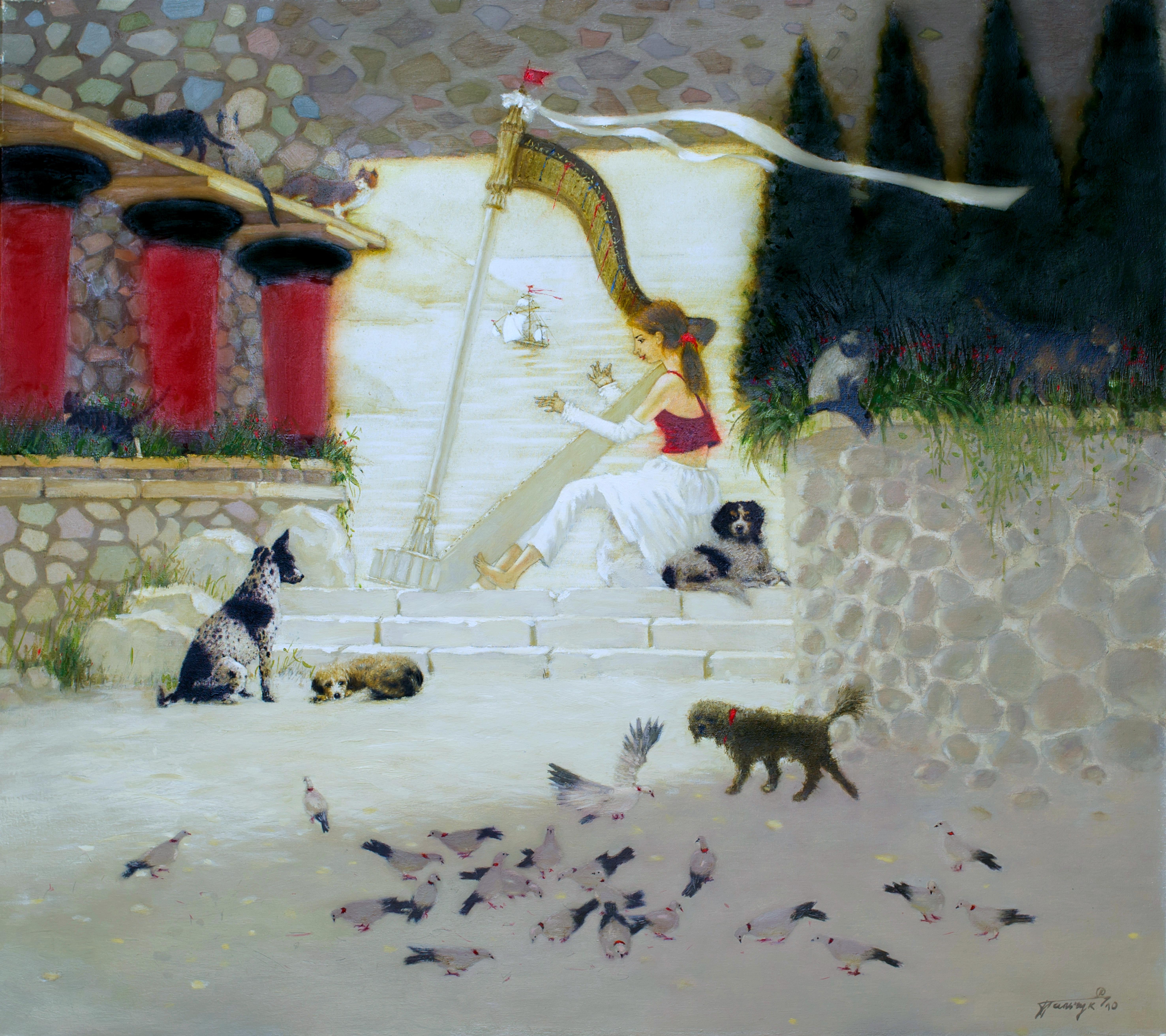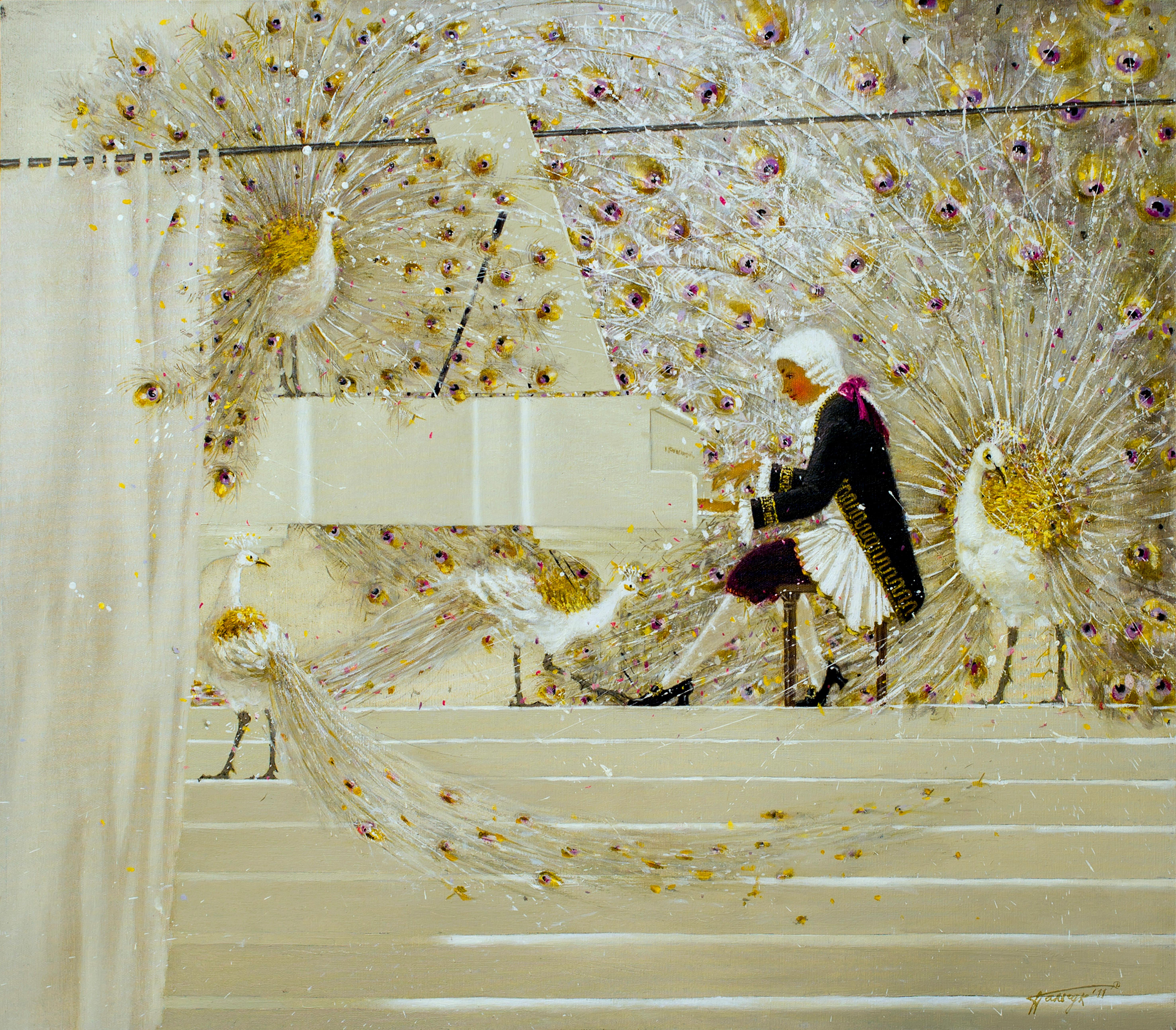Items Similar to 19th C, Romanticism, Genre Painting, Sheepstable
Want more images or videos?
Request additional images or videos from the seller
1 of 11
19th C, Romanticism, Genre Painting, Sheepstable 1849
1849
About the Item
Pieter Plas placed himself with this pastoral scene in the tradition of the 17th-century painters and draughtsmen such as Nicolaes Pietersz Berchem, Karel du Jardin, Marcus de Bye and Paulus Potter. Nevertheless, the work carries the typical ideals of Romanticism. The Romantics wanted to return to nature they idealized. They believed in a connection between the individual and nature. The harmony between the shepherdess and her flock of sheep is part of this story. This line of thought must be placed against the background of the advancing industrialization that began to put pressure on the traditional rural society. Plas lets the light subtly enter the barn through a doorway. The rays of the sun that illuminate the sheep -in a slightly diagonal line – add depth and vibrancy to the scene. The farmer's wife carries a bucket of milk. In the region of Alkmaar and Texel, milk of sheep was used to make cheese. Naturally, these animals also provided raw wool material. Hay is stored on the wooden beams of the stable. It was supplementary food for the sheep. Pieter Plas(1810-1853 came from a well-known Alkmaar artist family. His father and the first teacher was the carriage- and landscape painter Louwerencius Plas (1776-1847).
The painter himself was also a carriage painter until the age of 24. After two years in Hilversum with Willem Bodeman and with the animal painter Jan van Ravenswaay, he specialized in painting landscapes with cattle. The flat North Dutch landscape was often his source of inspiration. Pieter Plas had several pupils and was director of the Drawing Company 'Kunst zij ons doel' in Alkmaar. Museum Willet-Holthuysen in Amsterdam and the Teylers Museum in Haarlem expose some of his works. Plas signs with a long 's' at the end of his name.
- Attributed to:Pieter Plas (1810 - 1853, Dutch)
- Creation Year:1849
- Dimensions:Height: 28.75 in (73 cm)Width: 23.23 in (59 cm)
- Medium:
- Movement & Style:
- Period:
- Condition:
- Gallery Location:brussel, BE
- Reference Number:
About the Seller
5.0
Vetted Seller
These experienced sellers undergo a comprehensive evaluation by our team of in-house experts.
1stDibs seller since 2021
13 sales on 1stDibs
- ShippingRetrieving quote...Ships From: brussel, Belgium
- Return PolicyA return for this item may be initiated within 3 days of delivery.
More From This SellerView All
- Expressionism, Animal Painting, Auzoux's Troglodytes Gorilla's, Oil on Canvas.Located in brussel, BEAround the middle of the 19th century, the missionary Thomas Savage and the anatomist Jeffries Wyman described a new animal species – the Troglodytes Gorilla – in their Boston Societ...Category
21st Century and Contemporary Expressionist Animal Paintings
MaterialsCanvas, Oil
- 21st C., Expressionism, Animal Painting, Auzoux's Troglodytes GorillasLocated in brussel, BEAround the middle of the 19th century, the missionary Thomas Savage and the anatomist Jeffries Wyman, described a new animal species – the Troglodytes Gorilla – in their article for ...Category
2010s Expressionist Animal Paintings
MaterialsOil
- 21st C., Expressionism, Animal Painting, Auzoux's Troglodyte GorillasLocated in brussel, BEAround the middle of the 19th century, the missionary Thomas Savage and the anatomist Jeffries Wyman, described a new animal species – the Troglodytes Gorilla – in their article for ...Category
21st Century and Contemporary Expressionist Abstract Paintings
MaterialsCanvas, Oil
- 17th C, Baroque, Hunting Scene, Wild Boar Hunt in the style of Frans SnijdersLocated in brussel, BEHunting played an essential role in the lives of princes and nobles for centuries. It was no different in the 17th century. Paintings depicting hunting scenes were hung, for example, in the hunting lodges of elites. It should be noted that the upper bourgeoisie also began to show interest in painted hunting scenes during the 17th century. In the Southern Netherlands there were a number of skilled animal painters who produced hunting scenes, including Frans Snijders, Paul De Vos, Jan Roos, Pieter Boel and Jan Fyt. Snijders knew how to render the anatomy of the animals masterfully. Also, he managed to make his animals look intelligent. He let them express a variety of feelings. His colleague, Paul De Vos, seems to have been less familiar with animal anatomy. His animals lack a kind of individuality and psychological expression. The panel shows a boar hunt with dogs. It was a prevalent theme, portrayed by Rubens, Snijders, De Vos and others. Buyers were especially interested in the showdown between animal species. The mental and physical strength appealed to their imagination. The painter of this little work has no solid knowledge of dog breeds. Due to a lack of insight into dogs' bone and muscle structure, he makes them look rather stiff. Mainly the heads have something naïve about them. It cannot be ruled out that the artist of this painting is Jan van Kessel...Category
17th Century Baroque Landscape Paintings
MaterialsCanvas, Oak, Oil
- 16th C, Biblical, Manner of Joos van Cleve, Madonna with Child, Oil on PanelBy Joos van CleveLocated in brussel, BEAttentive observer, may I challenge you to find some unusual elements in this panel painting? One detail has to do with the symbolic use of color, the other with a later adjustment of the image. Indeed! The Blessed Virgin is not dressed in her usual sky blue cloak, which refers to her purity, but in a red robe. During the Late Middle Ages and early Renaissance, the Virgin often wore such a red garment to refer to the Passion of Christ. After all, the blessing Christ child with his orb would shed his blood for the redemption of mankind. The second strange element catches the eye when one looks closer at the little Jesus. It appears that he was originally depicted completely naked, but got on a transparent loincloth over time. In the past there were several times when nudity in art was subject to some form of censorship. For example, the supervision of Christian art was strongly encouraged by the Council of Trent (1545-1563). This assembly was dealing with the inner-ecclesiastical reform of the Roman Catholic Church. One of the important theologians who followed the council’s guidelines was Joannes Molanus (1533-1585). He did not consider the nakedness of the Christ Child to be edifying and pointed out that children could be endangered in this way. He may have been referring to the dangers of paedophilia. During the 19th century, puritanism emerged. A famous example of a moral preacher was Pope Pius IX...Category
16th Century Baroque Figurative Paintings
MaterialsCanvas, Oil
- 17th C Portrait of Russian Nobleman wearing Ushanka Hat, Flemish Shool.By David Teniers the YoungerLocated in brussel, BEThe portrait represents a man, estimated to be 60 years of age, standing turned to the viewer's right, looking at the viewer with a commanding expression. He has a moustache and beard and wears a high fur cap. He wears a brown mantle over a whitish shirt and, over it, a heavy gold chain...Category
17th Century Baroque Portrait Paintings
MaterialsOil, Wood Panel
You May Also Like
- "La faena del picador", 19th Century Oil on Canvas by Manuel Rodríguez de GuzmánLocated in Madrid, ESMANUEL RODRÍGUEZ DE GUZMÁN Spanish, 1818 - 1867 LA FAENA DEL PICADOR signed "M. Rodriguez" (lower left) oil on canvas 23 x 34-1/4 inches (58.5 x 87 cm.) framed: 31-5/8 x 43-1/8 inches (81 x 109.5 cm.) PROVENANCE Private Collector, Seville Manuel Rodríguez de Guzmán (Seville, June 20, 1818-Madrid, 1867) was a Spanish painter of the Romantic period who excelled in the composition of costumbrista themes. He began painting at the Royal Academy of Fine Arts of Santa Isabel de Hungría in his hometown with José Domínguez...Category
1850s Romantic Figurative Paintings
MaterialsCanvas, Oil
- Crete tune. 2010. Oil on linen, 80x90 cmLocated in Riga, LVCrete tune. 2010. Oil on linen, 80x90 cmCategory
2010s Romantic Figurative Paintings
MaterialsCanvas, Linen, Oil
- An Apples. 1998-2015. Oil on linen, 64, 5 x 75 cmLocated in Riga, LVAn Apples. ( To Steve Jobs Memory) 1998-2015. Oil on linen, 64,5 x 75 cmCategory
2010s Romantic Figurative Paintings
MaterialsCanvas, Linen, Oil
- Flute tune. 2008. Oil on linen, 80x100 cmLocated in Riga, LVFlute tune. 2008. Oil on linen, 80x100 cmCategory
Early 2000s Romantic Figurative Paintings
MaterialsCanvas, Linen, Oil
- Major. (from series Music) 2011. Oil on linen, 70 x 80 cmLocated in Riga, LVMajor. (from series Music) 2011. Oil on linen, 70 x 80 cmCategory
2010s Romantic Figurative Paintings
MaterialsLinen, Canvas, Oil
- Violet Melody (Accordion time). 2014. Oil on canvas, 50x60 cmLocated in Riga, LVViolet Melody (Accordion time). 2014. Oil on canvas, 50x60 cmCategory
2010s Romantic Figurative Paintings
MaterialsLinen, Oil, Canvas
Recently Viewed
View AllMore Ways To Browse
19th C Paintings
19th Century Romantic Painting
1849 Painting
Antique Connection
Antique Beams
Carriage Painting
Romanticism Painting
19th Century Painting Sheep
Jardin Painting
Wooden Beam
Antique Doorway
19th Century Cattle Paintings
The Antique Barn
Paintings With Hay
Antique Milk Paint
Flock Of Light
19th Century Rural Scene Painting
Flock Sheep


